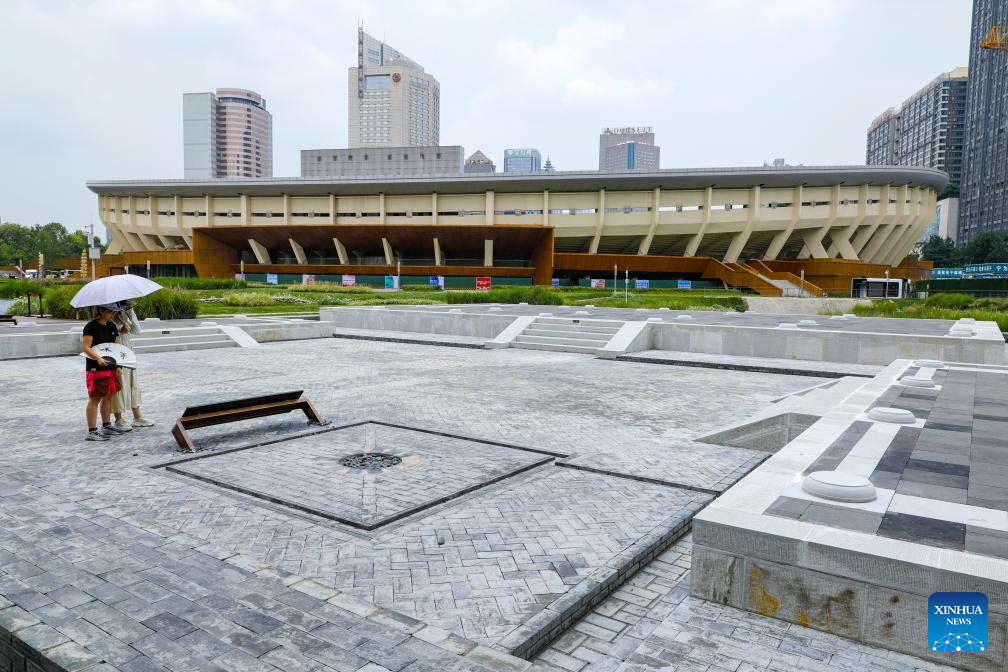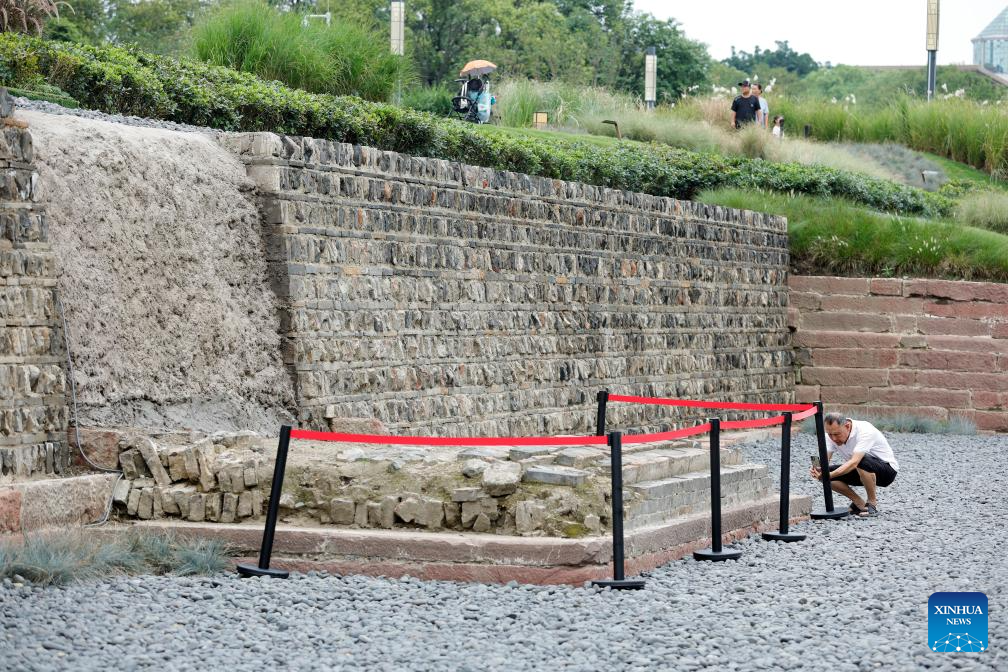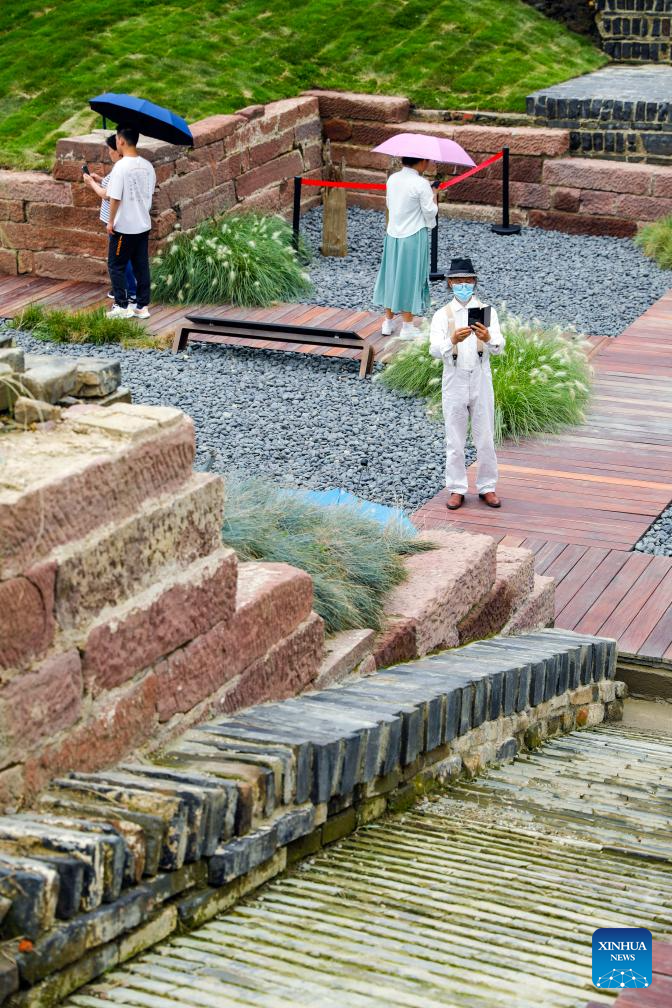Outdoor historical relics park opens new area to public in Chengdu

This aerial photo taken on July 20, 2023 shows an outdoor historical relics park in Chengdu, capital of southwest China's Sichuan Province. An outdoor historical relics park opened a new area to public on Thursday in Chengdu. The relics park is located in the core area of the old city of Chengdu. Since 2013, archaeologists have discovered a large area of ancient city remains from Donghuamen Street to Chengdu Sports Center in Qingyang District of Chengdu, with an excavated area of about 49,000 square meters, mainly including relics of Warring States Period (475-221 BC), Qin (221-207 BC) and Han (202 BC-220 AD) dynasties, Sui and Tang Dynasties (581-907), Song Dynasty (960-1279) and Ming Dynasty (1368-1644). (Xinhua/Shen Bohan)

People visit a canal ruins of the Ming Dynasty (1368-1644) in an outdoor historical relics park in Chengdu, capital of southwest China's Sichuan Province, July 20, 2023. An outdoor historical relics park opened a new area to public on Thursday in Chengdu. The relics park is located in the core area of the old city of Chengdu. Since 2013, archaeologists have discovered a large area of ancient city remains from Donghuamen Street to Chengdu Sports Center in Qingyang District of Chengdu, with an excavated area of about 49,000 square meters, mainly including relics of Warring States Period (475-221 BC), Qin (221-207 BC) and Han (202 BC-220 AD) dynasties, Sui and Tang Dynasties (581-907), Song Dynasty (960-1279) and Ming Dynasty (1368-1644). (Xinhua/Shen Bohan)

People visit a simulated yard relic of the Tang Dynasty (618-907) in an outdoor historical relics park in Chengdu, capital of southwest China's Sichuan Province, July 20, 2023. An outdoor historical relics park opened a new area to public on Thursday in Chengdu. The relics park is located in the core area of the old city of Chengdu. Since 2013, archaeologists have discovered a large area of ancient city remains from Donghuamen Street to Chengdu Sports Center in Qingyang District of Chengdu, with an excavated area of about 49,000 square meters, mainly including relics of Warring States Period (475-221 BC), Qin (221-207 BC) and Han (202 BC-220 AD) dynasties, Sui and Tang Dynasties (581-907), Song Dynasty (960-1279) and Ming Dynasty (1368-1644). (Xinhua/Shen Bohan)

People visit a canal ruins of the Ming Dynasty (1368-1644) in an outdoor historical relics park in Chengdu, capital of southwest China's Sichuan Province, July 20, 2023. An outdoor historical relics park opened a new area to public on Thursday in Chengdu. The relics park is located in the core area of the old city of Chengdu. Since 2013, archaeologists have discovered a large area of ancient city remains from Donghuamen Street to Chengdu Sports Center in Qingyang District of Chengdu, with an excavated area of about 49,000 square meters, mainly including relics of Warring States Period (475-221 BC), Qin (221-207 BC) and Han (202 BC-220 AD) dynasties, Sui and Tang Dynasties (581-907), Song Dynasty (960-1279) and Ming Dynasty (1368-1644). (Xinhua/Shen Bohan)

This aerial photo taken on July 20, 2023 shows a canal ruins of the Ming Dynasty (1368-1644) in an outdoor historical relics park in Chengdu, capital of southwest China's Sichuan Province. An outdoor historical relics park opened a new area to public on Thursday in Chengdu. The relics park is located in the core area of the old city of Chengdu. Since 2013, archaeologists have discovered a large area of ancient city remains from Donghuamen Street to Chengdu Sports Center in Qingyang District of Chengdu, with an excavated area of about 49,000 square meters, mainly including relics of Warring States Period (475-221 BC), Qin (221-207 BC) and Han (202 BC-220 AD) dynasties, Sui and Tang Dynasties (581-907), Song Dynasty (960-1279) and Ming Dynasty (1368-1644). (Xinhua/Shen Bohan)

A visitor takes photos of a canal ruins of the Ming Dynasty (1368-1644) in an outdoor historical relics park in Chengdu, capital of southwest China's Sichuan Province, July 20, 2023. An outdoor historical relics park opened a new area to public on Thursday in Chengdu. The relics park is located in the core area of the old city of Chengdu. Since 2013, archaeologists have discovered a large area of ancient city remains from Donghuamen Street to Chengdu Sports Center in Qingyang District of Chengdu, with an excavated area of about 49,000 square meters, mainly including relics of Warring States Period (475-221 BC), Qin (221-207 BC) and Han (202 BC-220 AD) dynasties, Sui and Tang Dynasties (581-907), Song Dynasty (960-1279) and Ming Dynasty (1368-1644). (Xinhua/Shen Bohan)

This aerial photo taken on July 20, 2023 shows an outdoor historical relics park in Chengdu, capital of southwest China's Sichuan Province. An outdoor historical relics park opened a new area to public on Thursday in Chengdu. The relics park is located in the core area of the old city of Chengdu. Since 2013, archaeologists have discovered a large area of ancient city remains from Donghuamen Street to Chengdu Sports Center in Qingyang District of Chengdu, with an excavated area of about 49,000 square meters, mainly including relics of Warring States Period (475-221 BC), Qin (221-207 BC) and Han (202 BC-220 AD) dynasties, Sui and Tang Dynasties (581-907), Song Dynasty (960-1279) and Ming Dynasty (1368-1644). (Xinhua/Shen Bohan)

This photo taken on July 20, 2023 shows an outdoor historical relics park in Chengdu, capital of southwest China's Sichuan Province. An outdoor historical relics park opened a new area to public on Thursday in Chengdu. The relics park is located in the core area of the old city of Chengdu. Since 2013, archaeologists have discovered a large area of ancient city remains from Donghuamen Street to Chengdu Sports Center in Qingyang District of Chengdu, with an excavated area of about 49,000 square meters, mainly including relics of Warring States Period (475-221 BC), Qin (221-207 BC) and Han (202 BC-220 AD) dynasties, Sui and Tang Dynasties (581-907), Song Dynasty (960-1279) and Ming Dynasty (1368-1644). (Xinhua/Shen Bohan)

This aerial photo taken on July 20, 2023 shows an outdoor historical relics park in Chengdu, capital of southwest China's Sichuan Province. An outdoor historical relics park opened a new area to public on Thursday in Chengdu. The relics park is located in the core area of the old city of Chengdu. Since 2013, archaeologists have discovered a large area of ancient city remains from Donghuamen Street to Chengdu Sports Center in Qingyang District of Chengdu, with an excavated area of about 49,000 square meters, mainly including relics of Warring States Period (475-221 BC), Qin (221-207 BC) and Han (202 BC-220 AD) dynasties, Sui and Tang Dynasties (581-907), Song Dynasty (960-1279) and Ming Dynasty (1368-1644). (Xinhua/Shen Bohan)

This aerial photo taken on July 20, 2023 shows a canal ruins of the Ming Dynasty (1368-1644) (R) and simulated relics of the Sui and Tang Dynasties (581-907) (L) in an outdoor historical relics park in Chengdu, capital of southwest China's Sichuan Province. An outdoor historical relics park opened a new area to public on Thursday in Chengdu. The relics park is located in the core area of the old city of Chengdu. Since 2013, archaeologists have discovered a large area of ancient city remains from Donghuamen Street to Chengdu Sports Center in Qingyang District of Chengdu, with an excavated area of about 49,000 square meters, mainly including relics of Warring States Period (475-221 BC), Qin (221-207 BC) and Han (202 BC-220 AD) dynasties, Sui and Tang Dynasties (581-907), Song Dynasty (960-1279) and Ming Dynasty (1368-1644). (Xinhua/Shen Bohan)

This aerial photo taken on July 20, 2023 shows a simulated yard relic of the Tang Dynasty (618-907) in an outdoor historical relics park in Chengdu, capital of southwest China's Sichuan Province. An outdoor historical relics park opened a new area to public on Thursday in Chengdu. The relics park is located in the core area of the old city of Chengdu. Since 2013, archaeologists have discovered a large area of ancient city remains from Donghuamen Street to Chengdu Sports Center in Qingyang District of Chengdu, with an excavated area of about 49,000 square meters, mainly including relics of Warring States Period (475-221 BC), Qin (221-207 BC) and Han (202 BC-220 AD) dynasties, Sui and Tang Dynasties (581-907), Song Dynasty (960-1279) and Ming Dynasty (1368-1644). (Xinhua/Shen Bohan)

People visit a canal stepped footpath ruins of the Ming Dynasty (1368-1644) in an outdoor historical relics park in Chengdu, capital of southwest China's Sichuan Province, July 20, 2023. An outdoor historical relics park opened a new area to public on Thursday in Chengdu. The relics park is located in the core area of the old city of Chengdu. Since 2013, archaeologists have discovered a large area of ancient city remains from Donghuamen Street to Chengdu Sports Center in Qingyang District of Chengdu, with an excavated area of about 49,000 square meters, mainly including relics of Warring States Period (475-221 BC), Qin (221-207 BC) and Han (202 BC-220 AD) dynasties, Sui and Tang Dynasties (581-907), Song Dynasty (960-1279) and Ming Dynasty (1368-1644). (Xinhua/Shen Bohan)

People visit a canal ruins of the Ming Dynasty (1368-1644) in an outdoor historical relics park in Chengdu, capital of southwest China's Sichuan Province, July 20, 2023. An outdoor historical relics park opened a new area to public on Thursday in Chengdu. The relics park is located in the core area of the old city of Chengdu. Since 2013, archaeologists have discovered a large area of ancient city remains from Donghuamen Street to Chengdu Sports Center in Qingyang District of Chengdu, with an excavated area of about 49,000 square meters, mainly including relics of Warring States Period (475-221 BC), Qin (221-207 BC) and Han (202 BC-220 AD) dynasties, Sui and Tang Dynasties (581-907), Song Dynasty (960-1279) and Ming Dynasty (1368-1644). (Xinhua/Shen Bohan)
Photos
Related Stories
- In Numbers: Chengdu prepares for green World University Games
- A look at people's life ahead of FISU Summer Universiade in Chengdu
- Chengdu ready for 31st FISU Summer World University Games
- Water quality of Jinjiang River in Chengdu improves due to ecology management
- 19th Western China International Fair held in Chengdu
Copyright © 2023 People's Daily Online. All Rights Reserved.









